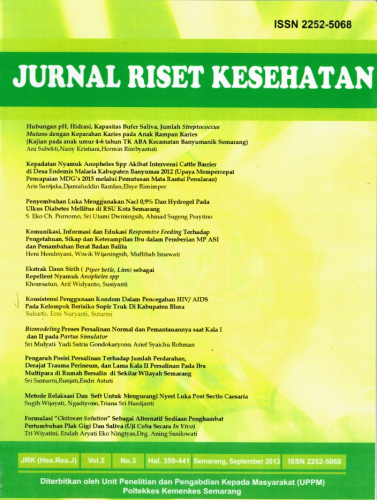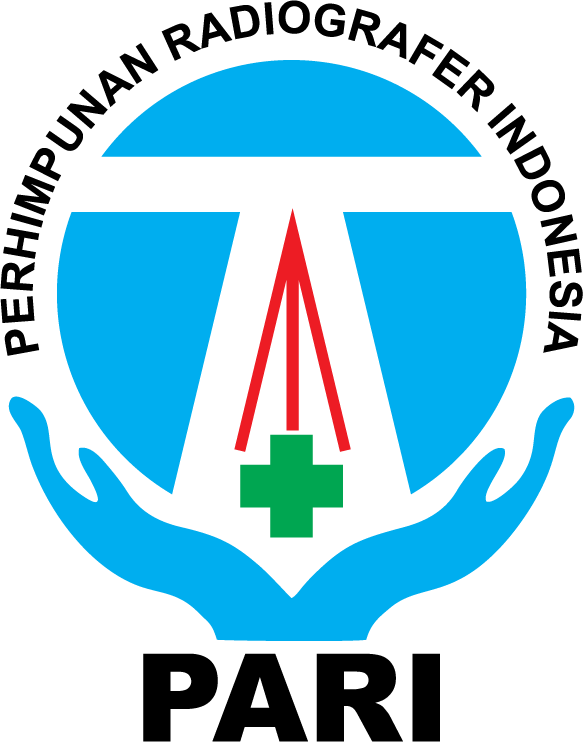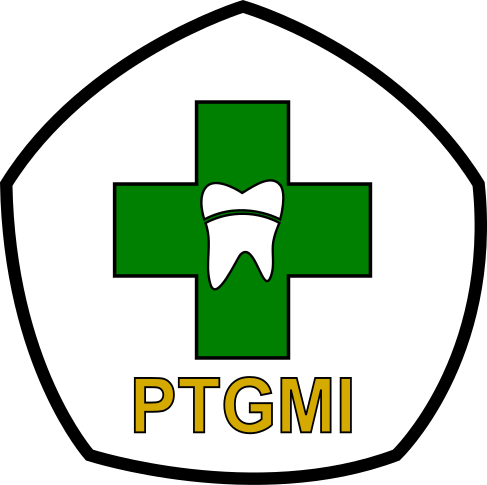THE INCREASE OF RIVER FLUOR CONTENT USING WHITE AND GREEN FLUORIDE STONE
Abstract
Fluoride content in water consumed by the people of Mekar Sari Village, Tatah Makmur District, Banjar Regency, South Kalimantan Province is still below the WHO recommendation and the Ministry of Health of Indonesia. This study aims to determine the differences in the ability of fluoride stones from the peat area - Liang Anggang, Banjar Regency and fluoride stones from Tanah Laut area of South Kalimantan in increasing fluoride content in river water. This type of work is analytical research. The experiments were carried out in river water by means of preliminary treatment until the turbidity is less than 5 NTU. Furthermore, the processed water was re-circulated into a “flour increase portable” device to manipulate the processed water with stones containing fluoride. Variations in research include 24 hours, 48 hours and 72 hours recirculation; fluoride stones types were from Liang Anggang area and from Tanah Laut. The results show that green stones from Tanah Laut area can increase fluoride content in processed river water to 0.63 mg / l. This means that the ability of this green stone is lower than that of white stone in increasing fluoride content in processed river water.
Keywords
Full Text:
PDFReferences
Aggeborn, L., & Mattias, O. (2021). The Effects of Fluoride in Drinking Water Linuz Aggeborn. Journal of Political Economy, 129(2), 465–489.
Aziz, T., Pratiwi, D. Y., & Rethiana, L. (2013). Pengaruh Penambahan Tawas Al2(SO4)3 dan Kaporit Ca(OCl)2 Terhadap Karakteristik Fisik dan Kimia Air Sungai Lambidaro. Jurnal Teknik Kimia, 19(3), 55–65.
Badan Pusat Statistik (BPS). (2018). Statistik Kesejahteraan Rakyat, 1–333.
Effendi, H. (2003). Telaah Kualitas Air Bagi Pengelolaan Sumber Daya dan Lingkungan Perairan. Jakarta.
García, M. G., & Borgnino, L. (2015). CHAPTER 1:Fluoride in the Context of the Environment. In Fluorine: Chemistry, Analysis, Function and Effects (pp. 3–21). https://doi.org/10.1039/9781782628507-00003
Hakim, W. L., Hasanah, L., Mulyanti, B., & Aminudin, A. (2019). Characterization of turbidity water sensor SEN0189 on the changes of total suspended solids in the water. Journal of Physics: Conference Series, 1280(2019), 1–7. https://doi.org/10.1088/1742-6596/1280/2/022064
Haris, A. (2011). Penurunan Debu Padi Menggunakan Wet Scrubber. Institut Teknologi Sepuluh Nopember Surabaya.
Husaini, & Haris. (2016). Sulfur Dioxide Removal of Smoke Area in Rubber Sheet Industri Using Wet Scrubber. IJABER, 14(5), 2817–2830.
Kılıç, Z. (2020). The importance of water and conscious use of water. International Journal of Hydrology, 4(5), 239–241. https://doi.org/10.15406/ijh.2020.04.00250
Maadid, H., Mzouri, E. H. El, Mabrouk, A., & Koulali, Y. (2017). Fluoride content in well waters for human and animal consumption with reported high incidence levels of endemic fluorosis in Beni Meskine ( Morocco ). Euro-Mediterranean Journal for Environmental Integration, 2(1), 1–6. https://doi.org/10.1007/s41207-017-0022-0
Popkin, B. M., D’Anci, K. E., & Rosenberg, I. H. (2011). Water, Hydration and Health Barry. Nutr Rev, 68(8), 439–458. https://doi.org/10.1111/j.1753-4887.2010.00304.x.Water
Rahmawati, I., & Said, F. (2017). Perancangan Alat Peningkatan Kadar Fluor Air Sungai Menggunakan metoda Kontak Bebatuan Mengandung Fluor Desa Mekar Sari Kecamatan Tatah Makmur Kabupaten Banjar Propinsi Kalimantan selatan. Poltekkes Banjarmasin.
Tarrass, F., Benjelloun, M., & Tarrass, F. (2012). The effects of water shortages on health and human development. Perspectives in Public Health, 132(5), 240–244. https://doi.org/10.1177/1757913910391040
World Health Organization (WHO). (1997). Guideline for drinking water quality, vol 3. Surveillance and control of community supplies. Geneva.
World Health Organization (WHO). (2004). Fluoride.
DOI: https://doi.org/10.31983/jrk.v10i1.6620
Article Metrics
Refbacks
- There are currently no refbacks.
Copyright (c) 2021 Jurnal Riset Kesehatan














































